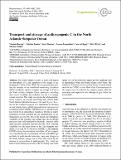Por favor, use este identificador para citar o enlazar a este item:
http://hdl.handle.net/10261/169477COMPARTIR / EXPORTAR:
 SHARE SHARE
 CORE
BASE CORE
BASE
|
|
| Visualizar otros formatos: MARC | Dublin Core | RDF | ORE | MODS | METS | DIDL | DATACITE | |

| Título: | Transport and storage of anthropogenic C in the North Atlantic Subpolar Ocean |
Autor: | Racapé, V.; Zunino, P.; Mercier, Herlé; Lherminier, Pascale; Bopp, Laurent; Pérez, Fiz F. CSIC ORCID ; Gehlen, Marion | Fecha de publicación: | 2018 | Editor: | European Geosciences Union | Citación: | Biogeosciences 15: 4661-4882 (2018) | Resumen: | The North Atlantic Ocean is a major sink region for atmospheric CO2 and contributes to the storage of anthropogenic carbon (Cant). While there is general agreement that the intensity of the meridional overturning circulation (MOC) modulates uptake, transport and storage of Cant in the North Atlantic Subpolar Ocean, processes controlling their recent variability and evolution over the 21st century remain uncertain. This study investigates the relationship between transport, air–sea flux and storage rate of Cant in the North Atlantic Subpolar Ocean over the past 53 years. Its relies on the combined analysis of a multiannual in situ data set and outputs from a global biogeochemical ocean general circulation model (NEMO–PISCES) at 1=2 spatial resolution forced by an atmospheric reanalysis. Despite an underestimation of Cant transport and an overestimation of anthropogenic air–sea CO2 flux in the model, the interannual variability of the regional Cant storage rate and its driving processes were well simulated by the model. Analysis of the multi-decadal simulation revealed that the MOC intensity variability was the major driver of the Cant transport variability at 25 and 36 N, but not at OVIDE. At the subpolar OVIDE section, the interannual variability of Cant transport was controlled by the accumulation of Cant in the MOC upper limb. At multi-decadal timescales, long-term changes in the North Atlantic storage rate of Cant were driven by the increase in air–sea fluxes of anthropogenic CO2. North Atlantic Central Water played a key role for storing Cant in the upper layer of the subtropical region and for supplying Cant to Intermediate Water and North Atlantic Deep Water. The transfer of Cant from surface to deep waters occurred mainly north of the OVIDE section. Most of the Cant transferred to the deep ocean was stored in the subpolar region, while the remainder was exported to the subtropical gyre within the lower MOC | Descripción: | 22 pages, 15 figures, 6 tables.-- This work is distributed under the Creative Commons Attribution 3.0 License | Versión del editor: | https://doi.org/10.5194/bg-15-4661-2018 | URI: | http://hdl.handle.net/10261/169477 | DOI: | 10.5194/bg-15-4661-2018 | ISSN: | 1726-4170 | E-ISSN: | 1726-4189 |
| Aparece en las colecciones: | (IIM) Artículos |
Ficheros en este ítem:
| Fichero | Descripción | Tamaño | Formato | |
|---|---|---|---|---|
| Transport_storage_anthropogenic_2018.pdf | 6,47 MB | Adobe PDF |  Visualizar/Abrir |
CORE Recommender
SCOPUSTM
Citations
6
checked on 20-abr-2024
WEB OF SCIENCETM
Citations
5
checked on 20-feb-2024
Page view(s)
326
checked on 19-abr-2024
Download(s)
260
checked on 19-abr-2024
Google ScholarTM
Check
Altmetric
Altmetric
Este item está licenciado bajo una Licencia Creative Commons

